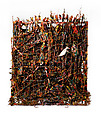History Refused to Die
Thornton Dial American
Not on view
One of the most revered contemporary self-taught artists, Dial integrated into his work mass-produced objects and organic materials, all infused with rich symbolic resonances. His impressive History Refused to Die incorporates torn and stained clothing, wire, and other common materials as well as okra stalks and roots. The plant serves as a metaphor for the shared history—the "roots"—of people whose personal genealogies tie back to Africa. Widely associated with Southern cuisine, okra is indigenous to Africa and, like many other foodstuffs, came to the Americas via the international slave trade. Its presence in Dial’s sculpture evokes the ecological transplantation that paralleled the forced displacement and enslavement of millions of Africans throughout the New World.
Due to rights restrictions, this image cannot be enlarged, viewed at full screen, or downloaded.
This artwork is meant to be viewed from right to left. Scroll left to view more.




